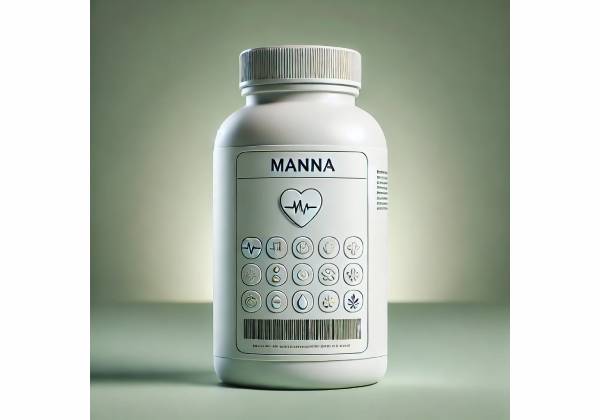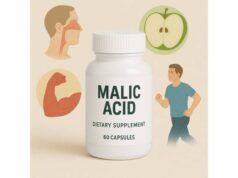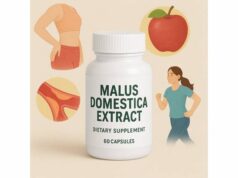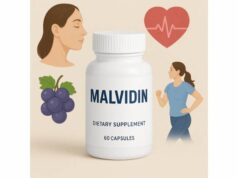
Manna is the naturally solidified sugary sap from the trunks of ash trees, especially manna ash (Fraxinus ornus) and narrow-leaf ash (Fraxinus angustifolia) traditionally cultivated in Sicily. When the bark is scored in summer, translucent filaments of sap dry on the trunk and are collected as “manna in cannolo” (long, hollow sticks) or as fragments (“rottame”). As a supplement and traditional remedy, manna is best known for its gentle laxative action thanks to its high content of D-mannitol, an osmotically active polyol. Modern analyses also show small amounts of phenolic compounds (e.g., hydroxytyrosol, catechin, fraxetin), which explain additional antioxidant and skin-focused properties observed in laboratory studies. Because manna is a minimally processed food-grade exudate, it appeals to people seeking a natural option for occasional constipation, a low-glycemic sweetener for specific recipes, or a topical ingredient in cosmetic formulations. This guide clarifies exactly what manna is, how it works, how to use it safely, and where the evidence stands today—so you can decide whether it fits your needs and how to dose it responsibly.
Key Insights
- Primary active is D-mannitol; typical products contain about 28–76 g mannitol per 100 g, depending on type and harvest.
- Main benefits: gentle relief of occasional constipation and supportive antioxidant activity in laboratory models.
- Practical oral range: 5–10 g for children and 10–20 g for adults as needed; do not exceed labeled directions.
- Common side effects are bloating and loose stools; stop if cramps, dehydration, or diarrhea occur.
- Avoid if pregnant or breastfeeding, after bowel surgery, or with suspected intestinal obstruction; use caution with diuretics and glucose-lowering therapies.
Table of Contents
- What is manna?
- Does it work and where it helps?
- How to take it and how much to use
- Using manna for common goals
- Safety, side effects, and who should avoid
- Evidence and research summary
What is manna?
Manna is the dried exudate obtained by making shallow, controlled incisions in the bark of specific ash trees during hot, dry months. As the sap seeps out, heat and airflow concentrate the sugars and polyols into glassy, white strands or flakes that collectors remove by hand. The best-known commercial grades are:
- Manna in cannolo: Long, hollow stalactites that form on guiding threads fixed to the trunk. This is the most prized form, typically cleaner and richer in mannitol.
- Manna rottame/sorte: Irregular fragments with more plant residues; composition is more variable.
What is in manna?
The dominant component is D-mannitol, often called “manna sugar.” Depending on cultivar, collection method, and processing, mannitol can range from roughly 28 to more than 60 g per 100 g in commercial material and even ~75 g per 100 g in some analyzed samples. Manna also contains fructose, glucose, and mannooligosaccharides (e.g., mannotriose), trace resistant starch, and a small phenolic fraction (hydroxytyrosol, tyrosol derivatives, catechin, fraxetin, verbascoside, and related compounds). The precise profile shifts with weather, tree genetics, and handling.
Why does it matter?
- Mannitol is poorly absorbed in the small intestine. It draws water into the lumen, softening stool and increasing stool volume—hence the gentle laxative effect.
- Phenolics function as antioxidants and signaling molecules in cells. While amounts in manna are modest compared with concentrated botanical extracts, laboratory studies show measurable reducing power and anti-inflammatory effects in cell models.
How is manna different from “mango leaf/seed extracts” or other “manna” products?
“Manna” here refers specifically to ash-tree sap. Other substances sometimes called “manna” (e.g., Persian manna from Alhagi species or eucalyptus exudates) are distinct materials with different compositions and uses. Always check labels for Fraxinus origin to avoid confusion.
Taste and kitchen use
Manna tastes mildly sweet with a cool, clean finish typical of sugar alcohols. It dissolves slowly and can be shaved or powdered into beverages or desserts. Because mannitol is less sweet than table sugar and has different crystallization behavior, treat it as a functional sweetener rather than a 1:1 sugar replacement.
Does it work and where it helps?
Occasional constipation (primary use)
Manna’s best-supported everyday use is as a gentle osmotic laxative. Since mannitol is poorly absorbed, it retains water in the intestinal lumen, helping to soften and mobilize stool. Traditional practice in Southern Italy has long used cannolo manna in children, older adults, and convalescents who benefit from a mild option. In practice, it works best when you also ensure adequate fluids and dietary fiber. Effects typically appear within 6–24 hours, depending on dose and individual sensitivity.
Antioxidant and anti-inflammatory support (emerging)
Hydrophilic extracts made from manna have shown the ability to quench free radicals (e.g., DPPH, ABTS assays), protect red blood cells from induced lipid peroxidation, and lower pro-inflammatory cytokine release (IL-6, IL-8) in intestinal cell models. These findings suggest a broader supportive role for gut barrier comfort and oxidative balance—still preclinical rather than definitive human clinical outcomes.
Dermatology and cosmetic potential
Topical investigations pairing manna extracts with hydrogels report anti-tyrosinase (pigmentation pathway) and anti-elastase activity, plus favorable pH and rheology for skin application. In keratinocyte models, manna-containing hydrogels have shown wound-closure support (scratch assays) without cytotoxicity at practical concentrations. These results motivate the use of manna as a supporting ingredient in brightening and barrier-care formulas rather than as a stand-alone active with guaranteed clinical outcomes.
Gastrointestinal milieu and “prebiotic-like” effects
Because mannitol is not fully absorbed, a portion reaches the colon, where it can be fermented by select microbes. This can be a double-edged sword: in modest amounts, it may contribute to microbial diversity and short-chain fatty acid production, but in higher doses it can cause gas and bloating—common to many polyols. People with IBS or those following a low-FODMAP plan are often sensitive to mannitol.
Metabolic health
Manna has a low glycemic impact relative to sucrose because mannitol is not efficiently metabolized to glucose. Still, commercial manna contains variable fructose and glucose, so it is not carbohydrate-free. If you have diabetes or prediabetes, consider manna a small, occasional addition and track your usual metrics; do not assume it is metabolically inert.
Microbial quality and food safety
Like honey and other concentrated sugary foods, manna’s high solids and low water activity limit microbial growth. Even so, the product can carry environmental yeasts and bacteria from harvest and drying. Commercial producers mitigate this with good collection hygiene and drying; home storage should be cool and dry. Discard if you notice visible mold or off-odors.
Bottom line
- Best supported day-to-day benefit: gentle relief of occasional constipation with appropriate hydration.
- Promising but early: antioxidant/anti-inflammatory actions and topical cosmetic roles.
- Manage expectations: manna is a traditional food-drug with mild effects, not a pharmacologic cathartic or an all-purpose antioxidant.
How to take it and how much to use
Forms you will encounter
- Whole or broken “cannolo” pieces: shaved, dissolved, or chewed.
- Powdered manna: easier to weigh and mix into liquids.
- Standardized hydrophilic extracts (for research or cosmetics): used mainly in topical formulations or specialty supplements; these are not the same as raw edible cannolo.
Oral dosing for constipation (general guidance)
Because manna is a traditional remedy rather than an approved drug in most countries, labels vary. The following ranges reflect common practice and the known laxative threshold of oral mannitol:
- Adults: 10–20 g manna as a single dose with 250–500 mL water, once daily as needed. Many people respond at 10–15 g; start low and adjust.
- Older children (≥6 years): 5–10 g with water.
- Younger children: Use only under professional guidance; if used, start at 2–5 g with careful monitoring.
- Do not exceed the product’s maximum daily amount. If no bowel movement occurs within 24–48 hours despite adequate fluids, stop and seek medical advice.
Timing
Take manna once, preferably in the morning or at bedtime, and allow 6–24 hours for effect. Avoid layering with other osmotic agents (e.g., high-dose vitamin C, sorbitol) on the same day to limit GI discomfort.
Hydration and diet
Manna works best when you drink sufficient water and maintain dietary fiber (vegetables, legumes, whole grains) on other days. On dosing days, favor soluble fiber (oats, psyllium) and electrolyte-rich fluids if stools become loose.
Topical/cosmetic use
For do-it-yourself formulators, hydrophilic manna extracts may be included at 0.5–2% in the water phase of serums or gels aimed at brightening or barrier support. Ready-made hydrogels with manna are typically formulated with pectin and set at a skin-friendly pH (~5.5–6.8). Always patch test new products for 24–48 hours before facial use.
Culinary use
Shave or powder manna and dissolve in warm beverages, herbal infusions, or dairy-free desserts for a subtle sweetness and cool finish. Because mannitol is less sweet than sucrose, start with 1–2 teaspoons (4–8 g) in a small serving and adjust.
Stacking and combinations
- For constipation, do not combine manna with other osmotic laxatives the same day.
- For general digestive comfort, separate manna days from polyol-rich sweeteners (xylitol, sorbitol, erythritol) to reduce bloating.
- For topical routines, pair manna-containing gels with niacinamide or panthenol; introduce one new active per week.
Quality checklist
- Origin and identity: Look for Fraxinus species, harvest location (e.g., Madonie, Sicily), and product type (cannolo vs. rottame).
- Purity: Favor producers who test for microbial quality and contaminants.
- Storage: Keep cool and dry; reseal promptly. Manna softens in humid air.
Using manna for common goals
1) Gentle relief of occasional constipation
- Plan: Start with 10 g in warm water once daily; increase to 15–20 g only if needed.
- Hydration: Add 250–500 mL fluids with the dose.
- Expectations: Softer stool within 6–24 hours.
- When to stop: If you develop cramping, watery diarrhea, or no improvement after two days. Seek medical care if symptoms persist or if you have red-flag signs (blood in stool, unexplained weight loss, fever).
2) Post-travel bowel regularity
- Plan: Use 10–15 g on the evening of arrival with water, then reassess the next morning.
- Tips: Prioritize fluids, magnesium-rich foods (leafy greens, legumes), and short walks to stimulate motility.
3) Low-glycemic sweetening in specific recipes
- Plan: Replace 10–30% of table sugar with powdered manna for a cool, mild sweetness in herbal tisanes, puddings, or chilled desserts.
- Notes: Large amounts can create texture changes and GI symptoms. Test small batches.
4) Topical brightening or soothing
- Plan (ready-made): Choose a hydrophilic gel formulated with 0.5–2% manna extract; apply once daily to clean skin.
- Plan (DIY): Add 0.5–1% manna extract to a pectin-based gel at pH ~5.5–6.5; store refrigerated for stability.
- Measure: Take standardized photos every 2 weeks; monitor for irritation.
5) Gentle support during recovery
- Plan: For individuals prone to hard stool after short immobility or medication changes (e.g., brief opioid use post-procedure), 10 g manna with water may be considered after clinician approval.
- Caution: Do not use with suspected bowel obstruction, severe dehydration, or ongoing opioid therapy without medical guidance.
Troubleshooting
- Too much gas/bloating: Cut the dose in half; avoid other polyols for 24 hours.
- Cramping or loose stools: Skip the next dose; focus on electrolytes (broth, diluted juice) and soluble fiber the following day.
- No effect after two trials: Switch to a different, guideline-supported approach under medical advice.
Safety, side effects, and who should avoid
Common, usually mild reactions
- Bloating and gas: Fermentation of mannitol by colonic bacteria can increase gas; start with the lowest effective dose.
- Loose stools/diarrhea: A sign that the dose is too high for your tolerance; reduce or discontinue.
- Abdominal cramping: Often dose-related; resolve by lowering dose or stopping.
Less common but important
- Dehydration and electrolyte shifts: Prolonged diarrhea can lead to lightheadedness, fatigue, or muscle cramps. Hydrate and seek care if symptoms persist.
- Allergy or sensitivity: Rare, but avoid if you have known mango/ash tree family allergies or oral allergy syndrome to ash pollen; seek professional advice first.
Who should avoid or use only with medical guidance
- Pregnant or breastfeeding individuals: Insufficient safety data—avoid routine use.
- Infants and very young children: Use only if specifically recommended by a pediatric clinician.
- People with suspected intestinal obstruction, acute abdomen, or unexplained persistent constipation: Do not self-treat with laxatives.
- Chronic kidney disease or severe dehydration: Osmotic shifts may worsen status; consult your care team.
- Irritable bowel syndrome or low-FODMAP diet followers: Mannitol is a FODMAP; even small amounts can trigger symptoms.
- Diabetes or prediabetes: Although mannitol itself has a low glycemic impact, commercial manna contains variable glucose/fructose. Monitor as you normally would and keep servings modest.
Interactions and cautions
- Diuretics or medications that affect electrolytes: Added fluid losses from diarrhea can intensify imbalances.
- Other osmotic agents (e.g., high-dose vitamin C, magnesium salts, lactulose, sorbitol): Combining increases the risk of GI distress.
- Glucose-lowering drugs: Not a direct interaction, but changes in diet or GI transit could affect meal timing and absorption; keep habits consistent and monitor as recommended.
Smart use checklist
- Use intermittently for occasional constipation, not as a daily crutch.
- Keep fluids and electrolytes up on dosing days.
- Stop and seek help if you experience persistent pain, fever, blood in stool, or unexplained weight loss.
Evidence and research summary
Composition and variability
Modern profiling of commercial manna batches confirms mannitol as the principal sugar alcohol, with mannose-based oligosaccharides, fructose, glucose, and a minor phenolic fraction. Some high-grade cannolo samples report manntiol levels above 60 g/100 g, while other commercial categories hover in the 28–37 g/100 g range. The phenolics—though modest in amount compared with concentrated botanical extracts—include hydroxytyrosol, tyrosol, catechin, fraxetin, verbascoside, and related compounds consistent with Fraxinus chemistry.
Laxative mechanism and thresholds
Oral mannitol is poorly absorbed and exerts a dose-dependent osmotic effect. Laboratory sources and pharmacology references place the laxative threshold in the ballpark of ~10–20 g in adults, which aligns with traditional manna dosing practices. This underpins the practical guidance to start at 10 g and titrate based on response and tolerance.
Antioxidant and anti-inflammatory data
Hydrophilic manna extracts show reducing capacity in chemical assays and cell-protective effects in erythrocyte and intestinal cell models—including lower lipid peroxidation and reduced IL-6/IL-8 release after pro-inflammatory challenge. These preclinical data are coherent with the known bioactivity of the identified phenolics, though they should not be over-extrapolated to clinical outcomes without human trials.
Topical potential
A recent study formulated manna extract in pectin hydrogels with skin-compatible pH and rheology. The preparations retained measurable antioxidant activity, demonstrated anti-elastase and anti-tyrosinase effects, and supported scratch-wound closure in keratinocyte cultures. For consumers, this suggests that manna-containing hydrogels may complement barrier care and tone-evening routines, pending robust clinical testing.
Microbial ecology and quality
Survey work on Sicilian manna mapped the cultivable microbial communities associated with different product categories. As with other high-sugar foods, yeasts (e.g., Lachancea thermotolerans) and Bacillus species appear as the dominant microbiota, and water activity helps explain load differences. Good collection practices and dry storage remain important for quality.
Oncology-oriented findings (exploratory)
In vitro, hydrophilic manna extracts have shown anti-proliferative effects in colon cancer cell lines through mitochondrial-pathway apoptosis and cell-cycle arrest. These are cell culture observations that generate hypotheses for future research; they are not evidence to recommend manna for cancer prevention or treatment.
Evidence gaps
- Randomized clinical trials of oral manna for constipation versus standard comparators in defined populations.
- Dose–response and tolerance studies across ages and comorbidities.
- Topical clinical trials (vehicle-controlled) confirming cosmetic benefits.
- Long-term safety data for regular oral use beyond intermittent dosing.
Practical conclusion
Manna is best viewed as a traditional, food-grade option for occasional constipation, with promising lab-based antioxidant and topical properties. Choose high-quality products, start with low, defined doses, and keep expectations consistent with a gentle, non-pharmaceutical remedy.
References
- Phenolic Composition of Hydrophilic Extract of Manna from Sicilian Fraxinus angustifolia Vahl and its Reducing, Antioxidant and Anti-Inflammatory Activity in Vitro 2019 (Experimental Study)
- Anti-Proliferative Activity of A Hydrophilic Extract of Manna from Fraxinus angustifolia Vahl through Mitochondrial Pathway-Mediated Apoptosis and Cell Cycle Arrest in Human Colon Cancer Cells 2020 (Experimental Study)
- Insights Into the Cultivable Microbial Ecology of “Manna” Ash Products Extracted From Fraxinus angustifolia (Oleaceae) Trees in Sicily, Italy 2019 (Observational Study)
- Evaluation of the Biological Activity of Manna Exudate, from Fraxinus ornus L., and Its Potential Use as Hydrogel Formulation in Dermatology and Cosmetology 2024 (Experimental Study)
- Fraxinus: A Plant with Versatile Pharmacological and Ethnomedicinal Uses 2017 (Review)
Medical Disclaimer
This article is for educational purposes only and is not a substitute for professional medical advice, diagnosis, or treatment. Always talk with your healthcare provider before starting or stopping any supplement, especially if you are pregnant or breastfeeding, have a medical condition, or take prescription medications. If you experience concerning symptoms—severe abdominal pain, persistent diarrhea, blood in stool, fever—stop using manna and seek medical care promptly.
If you found this guide helpful, please consider sharing it on Facebook, X (formerly Twitter), or any platform you prefer, and follow us on social media. Your support helps us continue producing careful, people-first health content.










